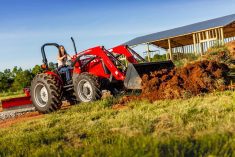The idea of the family farm is just that — a concept. The reality is that tax rules, inheritance law, good business practice and the fundamental problem of making a living have changed the family farm from a private business to the family corporation. Organization and tax rules are now almost as important as farm practices from germination to harvest. We’ll review the most important rules for their effects on profits.
The fundamental accounting question for farmers is whether to go on a cash-as-received-and-spent basis or on accrual. Cash is the most common choice, for farmers are price receivers. The market sets prices, rather than price-makers like General Mills that can set the price of its breakfast cereals. The farmer mostly takes cash as it comes.
Read Also

Gentle treatments for pain in the neck
Heading toward year-end, people unknowingly tense up against the cold and busyness, causing neck pain that can often be treated with appropriate support and gentle mobility, athletic therapist Kathlyn Hossack says.
“We always recommend that farmers go on a cash basis so they can adjust timing of purchase of inputs and recognize income as they wish,” explains Justin Chaput, a chartered professional accountant with Talbot and Associates based in Winnipeg.
If a farm will have startup losses, it can be set up as a corporation so the losses can be used for the farmer’s other income and even carried back to reduce prior income and tax. The $1 million farm capital gains exemption can be used by any farm owner. If the farm is a partnership, each partner can transfer assets to the existing partnership and after 24 months’ existence, transfer the capital gains deduction on the sale of the partnership interest to a corporation.
If a farm runs on a cash basis, then it is advantageous to buy supplies before year-end to increase expenses for a year. Credit card payments qualify as “paid” under tax rules. A promissory note or debt instrument such as a financing contract to a supplier for goods or services incurred in the tax year also qualifies — check with an accountant if it is a big item. If a farm is set up as a corporation, various persons in the corporation can have different classes of shares — a major planning opportunity. That can aid family financial planning, notes Colin Sabourin, a certified financial planner with Winnipeg Financial Planning.
Incorporating farms
There are many advantages to incorporating farms, Chaput notes. If a farm is a corporation and has no more than $500,000 net income, it can pay at a nine per cent tax rate. That is in contrast to personal rates that go up to 50 per cent or even more if the farmer is 65 or older and receives Old Age Security (OAS) subject to the clawback.
You can park the money and pay yourself a non-eligible dividend, that is, a rate less than the standard rate for individuals depending on bracket. Any money invested out of the farm income will be taxed at the usual rate. This strategy has a limit for older persons for crossing the limit into OAS clawback land, which currently starts at $79,845 and triggers the 15 per cent surtax on OAS payments for those aged 65 and over.
Income in the farmer’s hands is vulnerable. Note that if a farm has active income over the $500,000 cut-off for small business in respect of the nine per cent tax rate, it may be worth discussing with an accountant to have the farm issue eligible dividends that can benefit from the dividend tax credit. This is delicate accounting work that needs planning, Chaput notes.
All farm businesses whether incorporated or not need to use capital cost allowance accounting for property worth $500 or more. The full cost cannot be deducted for the year purchased. A silo, for example, is a Class 8 property. That means 20 per cent of the value can be deducted each year. But some ongoing expenses, such as veterinary fees for livestock, can be deducted in full in the year incurred on accrual or paid on cash accounting. If it’s a capital item rather than a service, long-term depreciation is the common rule.
A common strategy for preserving farm assets is division of the farm’s capital into different asset classes, notes Sabourin. “When you have common and preference shares in a corporate structure, it creates more ways to shelter capital and determine income distribution,” he says.
Trusts can be used to hold farm property. The advantage is the trust can distribute income among beneficiaries. The disadvantage is the cost of setting up trusts, accounting fees and the intra-family politics of running a farm through a trust. The structure can be used if there are many owners and many farms. For the average farmer, it’s a costly and unnecessary complication.
And if a farmer wants to give away property he or she no longer owns, say if the assets are owned by a corporation, the property may be land, inventory or equipment, the farmer can only will the shares in the corporation, says Allan M. Haubrich, a lawyer with Saskatoon’s Robertson Stromberg. The lesson is you cannot will what you do not own.
If a farm has a series of bad years and generates sequential losses, there is a risk the Canada Revenue Agency will consider it a hobby farm and deny deductions. A farmer who works full time and clearly tries to make a profit should not be a victim of several bad years, but to ensure that the farm or farm corporation can take losses, the farm can be set up as a partnership so each partner can take a maximum loss in a bad year of $17,500.
Where a farmer has the choice of generating a profit or loss, perhaps through variation on cost write-offs, it is often beneficial to show a profit. That enables the farmer to utilize non-refundable tax credits that might otherwise expire. Positive income distributed to or taken by a non-incorporated farmer can raise the Registered Retirement Savings Plan limit, and qualify the farm for the $1 million capital gains exemption.
More tips
There is a question of ownership of vehicles. If a vehicle is used at least 90 per cent by a farmer for his or her business, the hefty standby charge can be avoided. If personal use is less than 1,000 kilometres per month, the charge can usually be avoided.
If detailed and careful accounting and management are done and if a farmer can by use of various elections pay tax at an exceptionally low rate below the regular rate, the Alternative Minimum Tax (AMT) may be triggered. It is really a one-year charge that can be used in the following seven years provided there is sufficient income to generate enough tax to be written down. This process takes planning. If the person stuck paying the AMT dies before it is used up, too bad. The extra money paid will not be claimable after a final return is filed.
The bottom line on accounting and planning for transfers of farm ownership is while it is possible to save money when done, splits of ownership, such as transferring ownership so that a spouse and several kids share, there can be not just one $1 million exemption, but claims each for $1 million for each owner, says Don Forbes, head of Forbes Wealth Management in Carberry, Man. “Every trust and every partner in ownership has to file a return,” he explains. Cost is the bottom line and compliance is the limit to creative accounting.














